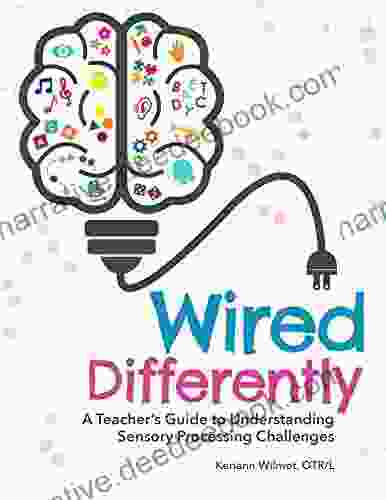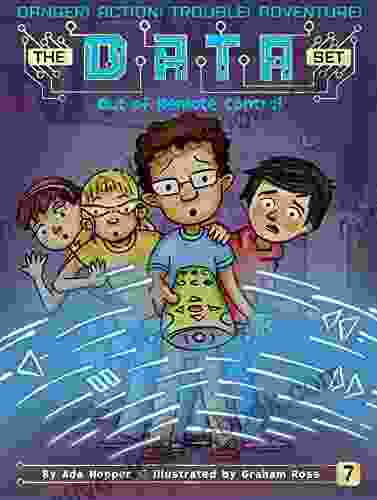Teacher Guide to Understanding Sensory Processing Challenges

Sensory processing challenges are a common issue for children and adolescents, affecting their ability to learn, socialize, and participate in everyday activities. As educators, it is essential to understand sensory processing challenges to create inclusive and supportive learning environments. This comprehensive guide will provide teachers with an in-depth understanding of sensory processing challenges, including their causes, symptoms, and evidence-based strategies for accommodating students in the classroom.
4.6 out of 5
| Language | : | English |
| File size | : | 2761 KB |
| Text-to-Speech | : | Enabled |
| Enhanced typesetting | : | Enabled |
| X-Ray for textbooks | : | Enabled |
| Word Wise | : | Enabled |
| Print length | : | 137 pages |
| Screen Reader | : | Supported |
What Are Sensory Processing Challenges?
Sensory processing challenges occur when an individual's nervous system has difficulty receiving, organizing, and interpreting sensory information from the environment. Sensory information can include touch, movement, sound, light, and smell. Individuals with sensory processing challenges may experience difficulty filtering out unnecessary sensory input, leading to difficulty focusing, emotional regulation, and motor skills.
Causes of Sensory Processing Challenges
The exact cause of sensory processing challenges is unknown, but researchers believe it may result from a combination of genetic and environmental factors. Certain risk factors, such as premature birth, low birth weight, and genetic conditions, may also increase the likelihood of sensory processing challenges.
Symptoms of Sensory Processing Challenges
Symptoms of sensory processing challenges can vary depending on the individual and the specific type of sensory challenge. Some common symptoms include:
- Sensory hypersensitivity (over-responsivity): Individuals may be overly sensitive to certain sensory stimuli, such as loud noises, bright lights, or rough textures.
- Sensory hyposensitivity (under-responsivity): Individuals may not respond to sensory stimuli that others find normal, such as pain or temperature changes.
- Sensory seeking: Individuals may engage in repetitive behaviors, such as rocking, chewing, or touching, to stimulate their senses.
- Sensory avoidance: Individuals may avoid certain sensory experiences, such as loud music or crowded spaces, due to discomfort or anxiety.
- Difficulty with transitions: Individuals may have difficulty adjusting to changes in sensory input, such as moving from a noisy classroom to a quiet library.
- Poor self-regulation: Individuals may struggle with emotional regulation and self-control in response to sensory challenges.
- Motor coordination difficulties: Individuals may experience challenges with balance, coordination, and fine motor skills due to sensory processing issues.
- Learning difficulties: Sensory processing challenges can interfere with attention, focus, and memory, impacting academic performance.
Evidence-Based Strategies for Accommodating Students with Sensory Processing Challenges
There are a variety of evidence-based strategies that teachers can implement in the classroom to accommodate students with sensory processing challenges. These strategies aim to minimize sensory overload, provide sensory supports, and promote self-regulation.
Sensory Modification
* Reduce sensory input: Create a calm and quiet learning environment by reducing noise levels, using soft lighting, and avoiding overwhelming scents. * Provide sensory breaks: Allow students to take breaks throughout the day to engage in preferred sensory activities, such as listening to calming music or using stress balls. * Offer sensory supports: Provide students with sensory tools, such as weighted blankets, fidget toys, and noise-canceling headphones, to help them manage sensory overload.
Self-Regulation Skills
* Teach deep breathing exercises: Deep breathing can help students calm down and self-regulate in response to sensory challenges. * Encourage mindfulness: Mindfulness practices, such as taking a few moments to notice their body and surroundings, can improve students' awareness of their sensory needs. * Provide visual and auditory cues: Visual and auditory cues can help students anticipate transitions and adjust to changes in sensory input.
Sensory Activities
* Incorporate sensory play: Sensory play, such as playing with water, sand, or dough, can provide opportunities for students to explore and regulate their sensory needs. * Offer sensory-based movement activities: Physical activities, such as jumping, running, or dancing, can help students process sensory input and improve motor coordination. * Create sensory corners: Dedicate a quiet corner in the classroom where students can retreat and engage in calming sensory activities.
Collaboration and Communication
* Collaborate with specialists: Consult with occupational therapists, physical therapists, or speech-language pathologists for professional support and tailored recommendations. * Communicate with parents: Share observations and strategies with parents to ensure consistency and support outside of the classroom. * Educate peers: Explain sensory processing challenges to other students to foster understanding and reduce stigma.
Understanding sensory processing challenges is crucial for teachers to create inclusive learning environments. By implementing evidence-based strategies, teachers can empower students with sensory challenges to succeed in the classroom and beyond. Remember that every individual's sensory needs are unique, and a personalized approach that considers their specific strengths and challenges is essential for maximizing their potential.
Author: Name of Author
Date: MM/DD/YYYY
Source: Website or Organization
4.6 out of 5
| Language | : | English |
| File size | : | 2761 KB |
| Text-to-Speech | : | Enabled |
| Enhanced typesetting | : | Enabled |
| X-Ray for textbooks | : | Enabled |
| Word Wise | : | Enabled |
| Print length | : | 137 pages |
| Screen Reader | : | Supported |
Do you want to contribute by writing guest posts on this blog?
Please contact us and send us a resume of previous articles that you have written.
 Novel
Novel Page
Page Chapter
Chapter Text
Text Story
Story Reader
Reader E-book
E-book Magazine
Magazine Paragraph
Paragraph Bookmark
Bookmark Shelf
Shelf Glossary
Glossary Bibliography
Bibliography Synopsis
Synopsis Annotation
Annotation Footnote
Footnote Tome
Tome Autobiography
Autobiography Memoir
Memoir Encyclopedia
Encyclopedia Thesaurus
Thesaurus Narrator
Narrator Character
Character Librarian
Librarian Catalog
Catalog Card Catalog
Card Catalog Borrowing
Borrowing Periodicals
Periodicals Study
Study Research
Research Lending
Lending Academic
Academic Journals
Journals Special Collections
Special Collections Interlibrary
Interlibrary Literacy
Literacy Study Group
Study Group Storytelling
Storytelling Awards
Awards Textbooks
Textbooks Michael Heatley
Michael Heatley Wendy Xu
Wendy Xu Tommy Orange
Tommy Orange Davies Cheruiyot
Davies Cheruiyot James Bender
James Bender E J Levy
E J Levy Andrew Young
Andrew Young Rose Elaine Lumley Brantley
Rose Elaine Lumley Brantley Colette Lacompte
Colette Lacompte Sam Vaseghi
Sam Vaseghi Ellen Anderson
Ellen Anderson Molly O Keefe
Molly O Keefe Nina De Gramont
Nina De Gramont Christine Kersey
Christine Kersey Bruce Grubbs
Bruce GrubbsD S O
 David Barrett
David Barrett Kevin Fortunato
Kevin Fortunato Ann Thompson
Ann Thompson Traci Hunter Abramson
Traci Hunter Abramson
Light bulbAdvertise smarter! Our strategic ad space ensures maximum exposure. Reserve your spot today!
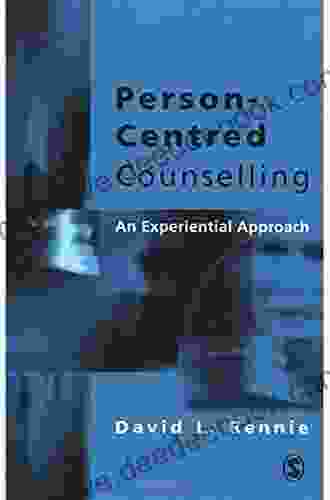
 Kenneth ParkerPerson Centred Counselling: An Experiential Approach to Emotional Well-being
Kenneth ParkerPerson Centred Counselling: An Experiential Approach to Emotional Well-being Tyrone PowellFollow ·11.7k
Tyrone PowellFollow ·11.7k Gene PowellFollow ·13.5k
Gene PowellFollow ·13.5k Craig CarterFollow ·16.2k
Craig CarterFollow ·16.2k David Foster WallaceFollow ·14.2k
David Foster WallaceFollow ·14.2k Ben HayesFollow ·14.7k
Ben HayesFollow ·14.7k Yasunari KawabataFollow ·15.1k
Yasunari KawabataFollow ·15.1k Haruki MurakamiFollow ·10.8k
Haruki MurakamiFollow ·10.8k Andy HayesFollow ·6k
Andy HayesFollow ·6k
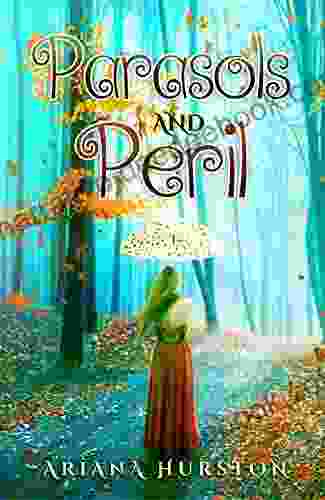
 Dallas Turner
Dallas TurnerParasols and Peril: Adventures in Grace
In the quaint town...

 Caleb Carter
Caleb CarterFlight Attendant Joe: A Dedicated Professional in the...
Flight Attendant Joe...

 Jerry Ward
Jerry WardPick Lottery The List For 23 States August 15 2024
The Pick Lottery is a multi-state lottery...
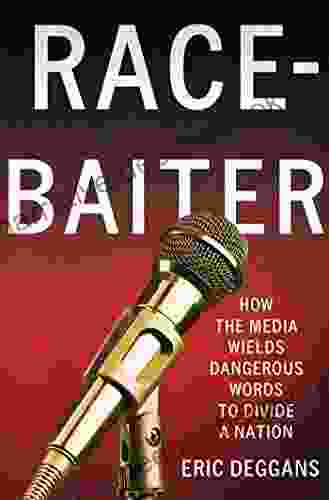
 Hudson Hayes
Hudson HayesHow the Media Wields Dangerous Words to Divide a Nation
In a world where the media is...

 Curtis Stewart
Curtis StewartThe Magic Mala: A Story That Changes Lives
In the realm of ancient traditions and...

 Raymond Parker
Raymond ParkerEarthly Meditations: A Poetic Tapestry of Nature,...
In the realm of contemporary...
4.6 out of 5
| Language | : | English |
| File size | : | 2761 KB |
| Text-to-Speech | : | Enabled |
| Enhanced typesetting | : | Enabled |
| X-Ray for textbooks | : | Enabled |
| Word Wise | : | Enabled |
| Print length | : | 137 pages |
| Screen Reader | : | Supported |


